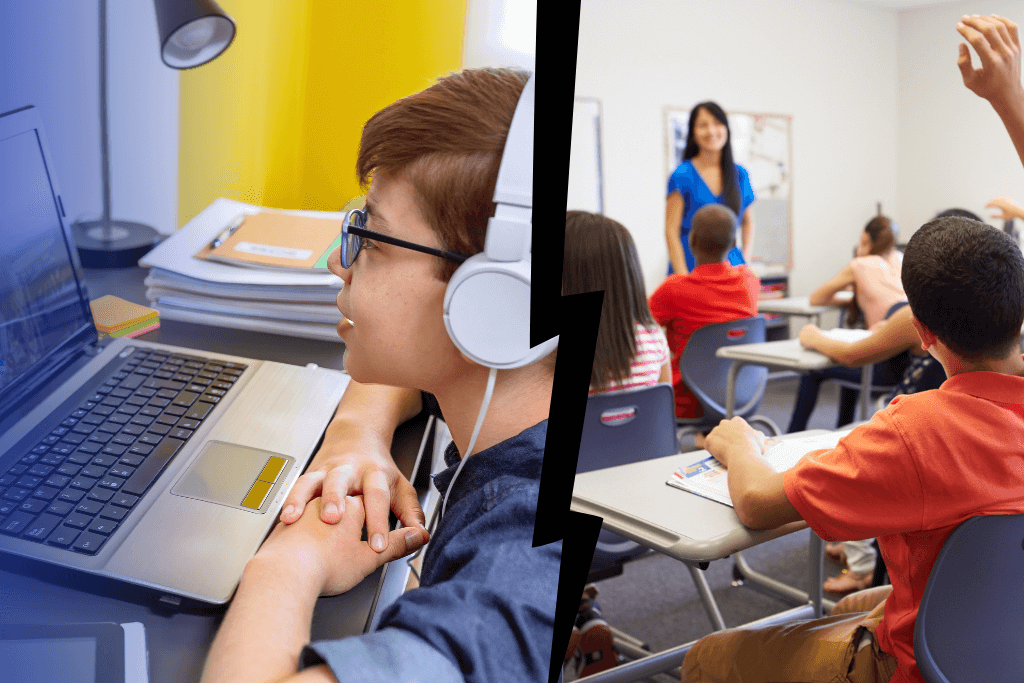
When considering the differences between online and on-site classes, it’s worth looking at both formats from the perspective of benefits, challenges, and preferences of both students and teachers. Online teaching, which has been dynamically developing over the past few years, has become an integral part of the offerings of many language schools.
But does it really differ in no way from traditional lessons? In today’s article, we will examine the key aspects of both teaching methods to help answer the question: online classes or on-site classes – which option to choose?
What will you find in this article?
- Differences between online and on-site classes
- How to prepare for online classes?
- Advantages of online and on-site classes
- Summary – online classes or on-site classes?
Differences between online and on-site classes
1. Learning environment
In on-site classes, students are present in a physical space, which facilitates direct interactions and relationship building. On the other hand, online classes take place in a virtual environment, requiring participants to have appropriate equipment and a stable internet connection.
Key differences include:
- Online classes: the ability to learn from anywhere, convenience, and flexibility.
- On-site classes: physical presence that supports relationship building and natural communication.
2. Technology vs. tradition
Technology plays a crucial role in online teaching. It requires the use of educational platforms, tools such as Zoom, Google Meet, or Microsoft Teams, and interactive multimedia materials. In contrast, on-site classes rely on traditional textbooks, blackboards, and real-time conversations.
Read our latest article and discover 8 useful AI tools for lecturers!
3. Participant engagement and attention
During online classes, attention can be more easily distracted, which necessitates the use of interactive teaching methods, such as:
- videos and animations,
- educational games,
- debates and group projects.
On-site classes allow teachers to quickly respond to students’ needs and directly engage them in exercises.
4. Flexibility and accessibility
Online classes enable schedule customization to meet individual needs, which is particularly appealing to those working or living in different time zones. However, on-site classes often occur at set times, which requires greater time discipline.

How to prepare for online classes?
Preparing for online classes requires appropriate technological and logistical support. Here are a few key steps.
Create the right environment
- Background: use a uniform, minimalist background to avoid distracting students.
- Lighting: ensure good lighting, preferably using LED ring lights.
- Equipment: a high-quality camera and microphone are essential.
Maintain eye contact
Position the video window close to the camera to maintain eye contact with participants during conversations. This builds rapport and increases engagement.
Utilize modern tools
Incorporating multimedia such as videos, audio, or quizzes makes online classes more engaging. Tools like Kahoot!, Quizlet, or Testinvite can help assess students’ skills in a modern and interactive way.
Discover all the benefits offered by online teaching at LangLion – convenience, automation, security, and modern solutions that facilitate teaching and management!
Advantages of online and on-site classes
Online classes
- Flexibility in time and location.
- Access to a wide range of multimedia materials.
- The possibility of participating in courses taught by teachers from different parts of the world.
On-site classes
- Building face-to-face relationships.
- Better control over the course of lessons.
- Natural interactions in the group.
Summary – online classes or on-site classes?
The differences between online classes and on-site classes are clear, but both formats have their unique advantages. The choice of the appropriate method depends on the individual needs and preferences of the student. However, it is important to remember that the key to success in learning is engagement, interactivity, and adapting teaching methods to meet the expectations of learners.
LangLion is a language school management platform, through which you can easily conduct online classes by integrating with Zoom, Clickmeeting, GoToMeeting, and MSTeams.
We provide automatic generation and sharing of meetings with the ability to join with „one click.” Each meeting has a unique link that ensures secure access and convenience for participants. Unlike other systems, there is no need to manually copy links – everything happens quickly and seamlessly.
